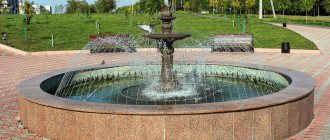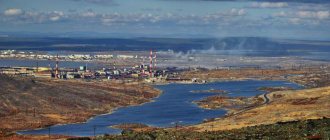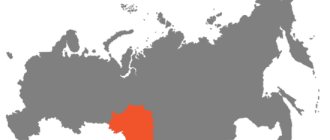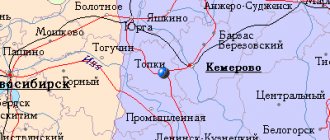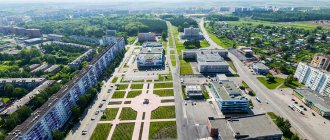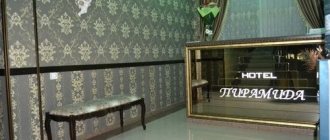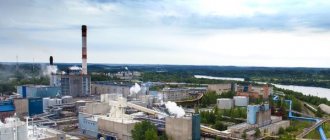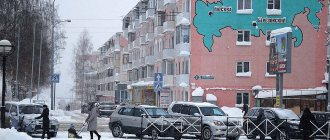This term has other meanings, see Mezhdurechensk (meanings).
| City | |
| Mezhdurechensk | |
| Flag | Coat of arms |
Moscow
Kemerovo
Mezhdurechensk
Media files on Wikimedia Commons| The article contains a list of sources, but lacks footnotes . Without footnotes, it is difficult to determine which source each individual statement comes from. You can improve the article by providing footnotes to sources that support the information. Information without footnotes may be deleted. |
Mezhdurechensk
- a city of regional subordination in the Kemerovo region of Russia. Together with eleven villages of the Mezhdurechensky district of the Kemerovo region, it forms a municipal entity - the Mezhdurechensky urban district. It is one of the largest cities in terms of population and the third largest city[5] in the Kemerovo region. Located in the south of Western Siberia, between the Tom and Usa rivers, in the southeastern part of the Kuznetsk coal basin (Kuzbass).
The city is part of the Novokuznetsk (Kuzbass) agglomeration, the population of which is about 1 million 150 thousand people (2013)[6]; it is the 12th largest in the country and the fourth in Siberia after the Novosibirsk, Krasnoyarsk and Omsk urban agglomerations; in addition to Novokuznetsk, it includes the cities of Kaltan, Kiselevsk, Mezhdurechensk, Myski, Osinniki, Prokopyevsk, as well as settlements of the Mezhdurechensky urban district, Novokuznetsky and Prokopyevsky municipal districts of the Kemerovo region. It is one of the few millionaire agglomerations in Russian non-millionaire cities[* 1].
By Order of the Government of the Russian Federation dated July 29, 2014 No. 1398-r “On approval of the list of single-industry towns,” the city was included in the category “Single-industry municipalities of the Russian Federation (monotowns), in which there are risks of deterioration of the socio-economic situation”[9].
Physiographic characteristics[ | ]
Geographical location
Mezhdurechensk is located in the southeast of the Kemerovo region, 63 km east of Novokuznetsk and 307 km southeast of Kemerovo, at an average altitude of 240 m above sea level, at the confluence of the Usa River with the Tom (hence the name). Mezhdurechensk is one of the most remote cities from the regional center. The distance to Moscow is 3,186 km in a straight line, 3,950 km by road[10].
| Distance from Mezhdurechensk to the nearest cities (in a straight line/by road)[10] | |||||||||
| Omsk ~ 963/1161 km Novosibirsk ~ 365/462 km Tomsk ~ 369/518 km Kemerovo ~ 223/307 km Leninsk-Kuznetsky ~ 163/225 km Belovo ~ 141/200 km | Mariinsk ~ 281/474 km | Krasnoyarsk ~ 398/831 km Achinsk ~ 326/667 km | |||||||
| Myski ~ 17/20 km Novokuznetsk ~ 63/75 km Prokopyevsk ~ 91/128 km Kiselevsk ~ 98/147 km Barnaul ~ 287/418 km. Zarinsk ~ 207/338 km. | Abakan ~ 222/976 km | ||||||||
| Biysk ~ 230/324 km Rubtsovsk ~ 522/710 km Gorno-Altaisk ~ 240/426 km | Tashtagol ~ 104/232 km Sheregesh ~ 86/230 km | Kyzyl ~ 485/1376 km | |||||||
Time zone
The city of Mezhdurechensk, like the entire Kemerovo region, is located in the MSK+4 time zone. The applied time offset relative to UTC is +7:00[11].
Climate
| The section lacks links to sources. Information must be verifiable or it may be deleted. You can edit the article to add links to authoritative sources. This mark was set on August 14, 2013 . |
Mezhdurechensk is characterized by a sharply continental climate with significant annual and daily temperature fluctuations, as well as large amounts of precipitation.
- Average annual temperature - 0.1 C°
- The average temperature in January is 35 C°
- Average July temperature + 18.5 C°
- Absolute temperature minimum - 48 C°
- Absolute temperature maximum + 39 C°
- Average annual wind speed - 2.9 m/s
- The frequency of calm situations in the city is 51%
- The average duration of the frost-free period is 107 days
The city is located in an area of sufficient moisture: on average, precipitation falls from 750 to 1400 mm per year. Snow cover is established in early November (in the mountains - in October). The height of the snow cover in the city area is about 1.0 m, in the mountains - from 2.5-3.0 m (on the slopes) to 4.0-7.0 m (in intermountain depressions). The process of melting snow and glaciers in the mountains annually creates the threat of flooding within the city limits. The duration of snow cover is about 160 days. The average depth of soil freezing in the city is about 190 cm. The predominant direction of winds is western and eastern.
Severe temperature conditions are accompanied by increased atmospheric humidity due to the location of the urban district between rivers in swampy areas. The situation is aggravated by the lack of sunlight (mostly cloudy or cloudy weather).
Climate and ecology of Mezhdurechensk
The scarcity of architecture (after the war there was no time for excesses, and subsequently active construction was carried out mainly during the reign of Khrushchev, with understandable consequences) is compensated by the abundance of green spaces and an enviable attention to cleanliness. The surrounding nature complements the pleasant impression - the picturesque surroundings of the city seem to simply beg to be painted onto an artist’s canvas.
A temperature of thirty degrees on the thermometer can be seen here both in winter and in summer. In winter, of course, with a minus sign. Although temperatures of minus twenty (for December-January) and plus twenty (for July) are more typical, you need to understand that what makes the local winters truly severe is the high humidity, due to the close proximity to rivers and swamps. There is a lot of snow in winter, and since city services are working properly, you need to prepare for the sight of two-meter snowdrifts that grow on the roadsides by spring.
The environmental situation is quite acceptable; the level of air pollution is much lower than in other industrial centers of the region. It is at least significant that the snow here in winter is really white - a fact that is truly amazing for a mining town in Kuzbass.
History[ | ]
| The section lacks links to sources. Information must be verifiable or it may be deleted. You can edit the article to add links to authoritative sources. This mark was set on August 14, 2013 . |
They took up the study of the southern part of Kuzbass [ who?
] in 1914. Leonid Lutugin, who led the study, named this area Tomusinsky (after the names of the Tom and Usa rivers). After his death, Vasily Yavorsky continued his work. During the Great Patriotic War, in connection with the occupation of Donbass by Nazi Germany, it was necessary to sharply increase coal production, so in 1943 large exploration work was launched by the Kuzbassuglegeologiya trust. From 1948 to 1949 the Novokuznetsk-Mezhdurechensk highway was built.
In 1949, Georgy Radchenko and his assistants began work in the middle reaches of the Olzherass River (the right tributary of the Usa River). In the gorge they discovered a unique [ specify
] deposit of fatty and coking coals, called “Raspadskoye”. This group of geologists prepared all the characteristics of the coal seams of the Tomusinsky region for the coal mine project and the immediate development of the area; the identified reserves accounted for a ninth of the coal reserves of the entire Kuzbass.
The first stage of twenty-seven prisoners left Stalinsk for the site where it was planned to build a camp for six and a half thousand prisoners, future builders of the mine and processing plant. It happened on March 27, 1948.
In 1952, the first construction department was created - Tomsk. And if before this the development was unplanned and made of wood, then with the formation of the administration the planned development of the city began on the opposite bank of the Usa River. In the same year and until 1953, logging was carried out in the village. Syrkash (now a district of Mezhdurechensk) the imprisoned ethnologist, geographer and historian Lev Nikolaevich Gumilyov was transferred [12].
On June 23, 1955, the village of Olzherass and the newly built city were united under the common name Mezhdurechensk.
In 1989, the first significant miners' strike in the USSR began in Mezhdurechensk.
On May 8-9, 2010, two methane explosions occurred at the Raspadskaya mine[13]. Discontent among miners, caused by the lack of response from local and federal authorities to demands for increased wages and improved working conditions, grew into mass civil unrest. Rallies took place on May 12 and 14[14][15]. During the rally on May 14, some of the protesters blocked the Novokuznetsk-Abakan railway and were dispersed by riot police[16]. In memory of the victims of the accident at the Raspadskaya mine, a chapel was built in honor of the Holy Great Martyr Varvara[17].
Coat of arms
| The section lacks links to sources. Information must be verifiable or it may be deleted. You can edit the article to add links to authoritative sources. This mark was set on August 14, 2013 . |
In 1966, a competition was announced for the best coat of arms of the city, in which 59 sketches were considered. After considering the submitted sketches, the design of the coat of arms, No. 48, was recognized as the best, which the Komsomol city committee proposed for approval.
The author of the coat of arms, Vadim Gushchin, despite violating a number of important laws of heraldry, managed to simply and originally, abandoning the traditional gears, flasks, and jackhammers of that time, reflect the industrial specifics, combining it with the natural and geographical position of the city.
On August 28, 1966, the newspaper Znamya Shakhtyora presented the coat of arms to the residents of Mezhdurechensk: “The shield is divided into two fields: red (above) - the color of labor and green (lower) - the color of the taiga. In the light of a spark, a piece of coal - our main wealth. On a green field there are two blue ribbons - Tom and Usa. Thus, the coat of arms personifies the two most important features of the city - the direction of the work of its inhabitants and natural conditions.”
The author of the coat of arms made a small mistake. The fact is that the Usa River flows into the Tom River from its right bank. In the 1966 coat of arms, converging rivers are depicted flowing to the left heraldic side (from the viewer to the right), which was not true. The error was corrected, and on March 18, 1993, the changed coat of arms was approved.
Districts and real estate of Mezhdurechensk
The city is small and is officially divided into only two districts - Western and Eastern. Interestingly, the unofficial zoning follows the official one, also dividing Mezhdurechensk into two large territories (with some nuances, of course).
Mezhdurechensk Map
The eastern district is usually called the “old town” or simply “the city”. Residents of the western part of Mezhdurechensk, heading here, say: “let's go to the city.” All administrative buildings, the Sports Palace, the main park of the city, and the main market are located here. There is already little housing being built in the city, and specifically in the eastern region there is a problem with new houses. On the secondary market you can find excellent “Stalin” apartments, although at a price slightly higher than the regional average (more about the cost of apartments below).
The area is relatively calm, clean, and looks attractive from the facade. The courtyards, of course, are less attractive, but this does not distinguish Mezhdurechensk from other Russian cities. The population, in a provincial way, is intolerant of new things, but if you do not have a long hair, are not a goth, not a hippie, it is quite possible to live here. You should always be prepared for the abundance of “gopniks” and the festivities of drunken miners (especially on weekends) (this is relevant for all areas). There is, perhaps, only greater wariness towards strangers in the “old Mesopotamia”, the private sector of the old city - where normal socialization can take quite a long time. At the same time, a private house in Mezhdurechensk can only be bought out of a great love for fiddling around in the garden; the lack of normal sewerage and hot water supply, and stove heating make the private sector very unattractive for visitors.
Eastern region
The western district of Mezhdurechensk is called “new”; there are more new buildings here, many high-rise buildings (and this territory began to be populated later than the old city). One of the streets (Kommunistichesky Prospekt) is completely pedestrian. Mezhdurechensk is generally a very green, very clean city, and on the “local Arbat” this is especially noticeable.
Mezhdurechensk Western region
The only unsightly place in Mezhdura is also in the west - Nakhalovka, where the private sector is localized. This is the dirtiest part of the city, partly due to the large percentage of marginalized people among the population, and partly due to a poorly organized garbage collection system. You can only buy housing here if you have a lot of money; in addition to all the typical problems of living in a private house, there are huge piles of waste on the streets.
In general, the New City is a pleasant place to live. In principle, the Old Town is in no way inferior to it (Mezhdurechensk is small anyway, and you can get to any point very quickly), but buying an apartment in the Western district is a more realistic task.
Housing prices can be unpleasantly surprising. The fact is that builders incur additional costs due to the need to build high seismic resistance (weak earthquakes in Mezhdurechensk have not surprised anyone for a long time, there have been no strong ones, but protection from them is necessary). Therefore, the price per square meter of 26-27 thousand rubles is considered gentle here (and is rare, 30-32 thousand per meter is common). If you try, it’s quite possible to find a “one-room apartment” within a million rubles, and a “two-room apartment” within one and a half. Prices on the secondary market are approaching prices for new apartments due to high demand. A small private house for 300 - 500 thousand will only be bought by someone who likes to overcome difficulties.
Population[ | ]
| Population | ||||||||||
| 1959[18] | 1962[19] | 1967[19] | 1970[20] | 1973[19] | 1975[21] | 1976[22] | 1979[23] | 1982[24] | 1985[25] | 1986[22] |
| 54 513 | ↗64 000 | ↗79 000 | ↗81 739 | ↗86 000 | ↗89 000 | →89 000 | ↗91 296 | ↗96 000 | ↗103 000 | →103 000 |
| 1987[26] | 1989[27] | 1990[28] | 1991[22] | 1992[22] | 1993[22] | 1994[22] | 1995[25] | 1996[25] | 1997[29] | 1998[25] |
| ↗104 000 | ↗107 014 | ↘104 000 | ↗108 000 | →108 000 | →108 000 | ↘107 000 | ↘105 000 | ↘104 000 | →104 000 | →104 000 |
| 1999[30] | 2000[31] | 2001[25] | 2002[32] | 2003[19] | 2004[33] | 2005[34] | 2006[35] | 2007[36] | 2008[37] | 2009[38] |
| ↗104 500 | ↘104 400 | ↗105 300 | ↘101 987 | ↗102 000 | ↗102 300 | ↗103 000 | ↗103 700 | ↘103 500 | ↗103 800 | ↗103 950 |
| 2010[39] | 2011[40] | 2012[41] | 2013[42] | 2014[43] | 2015[44] | 2016[45] | 2017[46] | 2018[47] | 2019[48] | 2020[49] |
| ↘101 678 | ↘101 575 | ↘100 725 | ↘99 809 | ↘98 895 | ↘98 831 | ↘98 734 | ↘97 895 | ↘97 060 | ↘96 159 | ↗96 299 |
| 2021[50] | ||||||||||
| ↘96 088 | ||||||||||
Population as of January 1, 2022: 96,088.
As of January 1, 2022, in terms of population, the city was in 177th place out of 1,116[51]cities of the Russian Federation[52].
Vesennyaya Street in Mezhdurechensk
Unfortunately, here in Mezhdurechensk on Vesennyaya Street on May 31, 2016, a terrible tragedy occurred. During renovations in the store on the 1st floor, the load-bearing structures were probably damaged, which led to the collapse of the entire entrance. 2 people died. The house has already been demolished.
Vesennaya Street itself is all in flowers.
City management[ | ]
Authorities and city management
According to the Charter of the Mezhdurechensky urban district[4]:
- The Council of People's Deputies of the Mezhdurechensky Urban District is a representative body of local government,
- The head of the Mezhdurechensky urban district is the head of the municipal formation,
- Administration of the Mezhdurechensky urban district is the executive and administrative body of the municipality,
- The Chamber of Control and Accounts of the city of Mezhdurechensk is the financial control body of the municipality.
Heads of the city
| This section of the article has not been written. According to the plan of one or more Wikipedia contributors, a special section should be located in this place. You can help by writing this section. This mark was set on December 31, 2016 . |
Council of People's Deputies
| The section lacks links to sources. Information must be verifiable or it may be deleted. You can edit the article to add links to authoritative sources. This mark was set on August 17, 2022 . |
In 2013, 17 deputies from United Russia, 2 from SR, 2 from LDPR, 1 from the Communist Party of the Russian Federation were elected to the council. In the 2022 elections, United Russia received 31%, LDPR - 24%, Communist Party of the Russian Federation - 21%, SR - 17%. There are factions: United Russia - 12 people, SR - 3 people, Communist Party of the Russian Federation - 3 people. , and non-fractional (8 people). There are 26 deputies in total.
Arbat of the city of Mezhdurechensk - Kommunistichesky Avenue
The main street of Mezhdurechensk is the pedestrian Kommunistichesky Avenue.
Avenue.
At the head of the avenue, of course, stands V.I. Lenin.
A bird of peace is basking in the sun.
There is a huge sundial right in the center of the avenue.
The architecture of Stalinist five-story buildings in Mezhdurechensk carries a certain charm. If you look closely, you can see symbols of the Soviet era.
Fountains
Without fountains the city would be quite dull.
While the children are splashing in the fountain, the heat is intensifying; the sun is already +37C.
TV tower.
The longest Kommunistichesky Avenue is 1.5 kilometers.
Place de la Concorde
The main fountain of the city of Mezhdurechensk is located on Concord Square.
The former office of the Raspadskaya mine looks more like a city administration.
Police department for the city of Mezhdurechensk.
The sculptor did not bother much with the characters of Eduard Uspensky.
Crocodile Gena actually looks more like a pea pod))
Kommunistichesky Avenue ends with the Raspadsky Palace of Culture.
Economics[ | ]
| Check information. It is necessary to check the accuracy of the facts and reliability of the information presented in this article. There should be an explanation on the talk page. |
Railway station "Mezhdurechensk-Passenger"
The main branch of the economy is the extraction of hard coal (coking and steam coals), supplied mainly to ferrous metallurgy plants and power plants in Southern Kuzbass.
- Mines: Raspadskaya (the largest in Russia, part of the coal mining company of the same name, whose headquarters are also located in the city), OJSC Mezhdurechenskaya Coal Company - 96 (mothballed in 2016), Raspadskaya Koksovaya, im. Lenina", "Tomskaya" (closed), "Olzherasskaya-nova". (The Shevyakov Mine was closed after an accident on December 1, 1992, which killed 25 miners).
- Sections: “Krasnogorsky”, “Olzherassky”, “Mezhdurechensky”, “Tomusinsky”, “Raspadsky”.
- Factories for the enrichment of mined coal: “Kuzbasskaya”, “Tomusinskaya”, “Krasnogorskaya”, “Raspadskaya”, “Mezhdurechenskaya”.
- Gold mining enterprises: CJSC Artel Prospectors "Golden Pole".
The management of OJSC Coal Company Southern Kuzbass, subordinate to the Mechel group, is located in the city. The enterprises that are part of the company produce coal both underground (Olzherasskaya-Novaya mine, Lenin mine, Sibirginskaya mine, Erunakovskaya mine under construction) and open pit (Krasnogorsky, Olzherassky, "Sibirginsky") method. The coal company also includes enterprises for processing and enriching coal (Tomusinskaya GOF, Kuzbasskaya POF, Krasnogorskaya POF, Sibir POF, Sibirginskaya POF under construction)[54].
For the type of activity “mining”, the volume of shipped products in actual prices for 2009 amounted to 40.52 billion rubles. In 2009, large and medium-sized enterprises of the city produced 24.3 million tons of coal. Manufacturing enterprises shipped goods of their own production, performed work and services on their own in 2009 in the amount of 1.429 billion rubles.
Manufacturing industry
Tomusinsky Mechanical Repair Plant [55]
Food industry
4 enterprises bake bread in the city; the main market share is occupied by OJSC Khlebokombinat.
OJSC Slavyanka produces beer and carbonated drinks, providing its products not only to Mezhdurechensk, but also to nearby cities in Siberia.
Not far from the village. Usinsky produces drinking and mineral water under the Yugus brand.
Trade and catering
Trade and public catering in the city are represented by 5 markets, 400 shops (199 selling food and 201 selling non-food products). [ source not specified 2626 days
] Public catering is represented by 2 restaurants, 26 bars and cafes and 5 canteens.[
source not specified 2626 days
]
Banks
- Orient Express Bank
- VTB Bank
- MosOblBank
- Sberbank of Russia
- Sovcombank
- Coalmetbank
- Bank "Uralsib"
- Home Credit and Finance Bank
- OTP Bank
The impact of the global financial crisis of 2008 on the city's economy
In October 2008, due to the fall in demand for steel and its prices, the problem of reducing demand for mined coal arose. The problem was aggravated by delays in a significant amount of payments to coal suppliers from metallurgical plants for coal already supplied. The city's coal enterprises, which employ almost 50% of the working population, have reduced work shifts by an average of 20%, as well as suspended social payments, which are not mandatory under the Labor Code of the Russian Federation. All this led to a significant drop in income of the city's population. As of mid-February 2009, there were no mass layoffs at the city's coal enterprises.
Starting in May 2009, it transferred its employees to work full-time.
Transport
| The section lacks links to sources. Information must be verifiable or it may be deleted. You can edit the article to add links to authoritative sources. This mark was set on August 14, 2013 . |
Activities for transporting passengers by public road transport are carried out by 88 buses (schedules), operating daily on the route network of the Mezhdurechensky urban district (including 14 buses (schedules) of the Mezhdurechensky State Enterprise ATP KO and 74 buses (schedules) of commercial organizations).
Transportation by passenger transport is carried out by several private taxi companies, Kuzbass, Grand, Alliance, Next, Yandex.Taxi.
Intercity bus to Novokuznetsk, Kemerovo, Tashtagol, Tomsk, Novosibirsk, Barnaul.
How to get to Mezhdurechensk
Mezhdurechensk is located in the south of western Siberia. The most convenient way to get to the city of Mezhdurechensk in the Kemerovo region is through Novokuznetsk. If you are planning to fly, then plane tickets to Novokuznetsk at the best price for dates convenient to you can be purchased here. On our website there is a separate article about Spichenkovo Airport. To immediately get to Mezhdurechensk from the airport, you can order a transfer. They will meet you, help you with your luggage and take you right to your doorstep. You can order a transfer on this website. Of course, it will be cheaper to travel by train through Novokuznetsk, but this may take half a day.
From the Novokuznetsk bus station you can go to Mezhdurechensk almost around the clock. There are several buses per hour. Travel time is about 2 hours or a little less, depending on traffic jams in Novokuznetsk. You can purchase a bus ticket online here.
Train and train schedules
Please note that there are 2 railway stations in Mezhdurechensk: Mezhdurechensk-Gorod and Mezhdurechensk-Pasazhirsky. More electric trains pass through Mezhruchensk-Pasazhirsky. Electric trains from the City leave 10-15 minutes earlier.
Only one train runs through the city of Mezhdurechensk on the Abakan-Barnaul route.
Sports[ | ]
| The section lacks links to sources. Information must be verifiable or it may be deleted. You can edit the article to add links to authoritative sources. This mark was set on August 14, 2013 . |
The city is one of the centers of alpine skiing in Russia: a giant slalom track, a special slalom track, a rental point, both tracks are equipped with rope tows and chair lifts, a ski jump complex, a ski base, and hotels.
There are 7 children’s and youth sports schools in the city: a comprehensive school for sports games (volleyball, basketball), football, ice hockey and figure skating, a martial arts school, two Olympic reserve schools for alpine skiing, ski jumping and Nordic combined. There is also one commercial paintball club and a laser tag club, Polygon 42.
There are more than 150 sports facilities for sports, including: the Crystal Ice Palace, 2 stadiums, 3 ski lodges, a shooting range, a swimming pool, gyms, and a paintball arena.
Every year in April, the Vesnyanka water tourism competition is held on the Olzheras River, bringing together athletes from many cities in Siberia.
The Vympel hockey team was a five-time champion of the 1st League, but ceased to exist. Football club "Raspadskaya", multiple winner of the zonal tournament of the Russian championship among amateur teams of the third division.
Tourism and recreation Mountain range "Celestial Teeth"
Mezhdurechensk is surrounded not only by two clean rivers, but also by mountains. 60 km east of the city is the Celestial Teeth mountain range, which is popular among Siberian tourists who go on summer hiking and winter ski trips.
A little further than the Celestial Teeth, the Kazyr River flows, along which mostly trained tourist boaters raft (difficulty reaches category 5). Lovers of a relaxing holiday can raft on the Tom and Usa rivers.
To the north of the city there is the Kuznetsky Alatau nature reserve. One of the tourist routes of the reserve - “Rafting along the Usa River” - passes through the territory of the Mezhdurechensky urban district[56]. To visit it, you must obtain a permit from the administration of the reserve, which is also located in Mezhdurechensk. At the entrance to the city there is an ecological one, where there is an aviary complex with wild animals, the Wings Center for the Rehabilitation of Wild Birds, the Museum of Nature, and horse rental[57].
Sanatorium-resort organizations are represented by the Solnechny sanatorium for 150 beds and the Romantika sanatorium-preventorium for 220 beds. There are several recreation centers, the largest of which is the “Fantasy” health complex with 47 places.
Usa River in Mezhdurechensk
Arriving in the center of Mezhdurechensk, we saw a bridge over the Usa River. On the right bank of the river there is the village of Olzheras and the Raspadskoye coal deposit. Of course, I couldn’t resist going to the bridge.
The bridge is both a road and a railway bridge, something you don’t see often.
Usa River.
Mezhdurechensk is located at the confluence of the Usa and Tom rivers, exactly between them. Actually this is reflected in the name of the city Mezhdu-Rechensk.
Media[ | ]
| The section lacks links to sources. Information must be verifiable or it may be deleted. You can edit the article to add links to authoritative sources. This mark was set on August 14, 2013 . |
Press
- "Contact"
- "The Miner's Banner in the New Millennium"
- "Chastnik-M"
- "Advertising Mezhdurechensk"
A television
- First channel
- Russia 1 / State Television and Radio Broadcasting Company Kuzbass
- TV Center
- NTV
- Channel 5
- REN TV
- STS (STS-Kuzbass)
- TV3
- TM-KVANT (City TV channel)
- Mezhdu.net (City TV channel)
Radio stations
- 70.6 FM – Radio Russia
- 93.4 FM – Road Radio
- 97.5 FM - Humor FM
- 99.8 FM – Radio Dacha
- 100.2 FM – Apex Radio
- 100.8 FM – Radio Russia
- 101.8 FM - Kuzbass FM, with local radio "KVANT Radio" included
- 103.3 FM - Europe plus
- 103.7 FM – Russian radio
- 104.7 FM - NRJ
- 105.3 FM - Radio for two
- 106.4 FM – Radio Vanya
- 107.7 FM – Autoradio
Communication[ | ]
| Check information. It is necessary to check the accuracy of the facts and reliability of the information presented in this article. There should be an explanation on the talk page. |
Telephone number in the city is 38475. Long-distance telephone communication is provided by Sibirtelecom OJSC and RICT OJSC (IP telephony).
Unlike most cities in Kuzbass, local telephone communication is provided not by RIKT, but by JSC RICT. On the one hand, this situation made it possible in the early 90s to replace outdated PBX equipment with modern Italian equipment (the Italian company Italtel [en] then became one of the company’s shareholders) and set its own tariffs for telephone communications. On the other hand, OJSC RIKT is also an Internet provider, and for a long time occupied a huge share in the market for Internet access services, not giving the opportunity to other providers to develop due to time-based payment for telephone communications.
In 2022, RIKT JSC was absorbed.
As of January 2022, 5 providers provide Internet access to the population:
- RTA Telecom LLC
- PJSC "MTS"
- JSC Rostelecom
- LLC "Intex"
- Siberian Networks LLC (Ethernet).
In 2000, JSC RIKT launched the city Intranet network, later renamed MezhduNet, which includes several information and entertainment resources.
In 2006, RICT OJSC and Zavod RTA LLC created a peer-to-peer network, but in 2007, at the initiative of RICT, relations were severed. A year later, “we signed a peer-to-peer agreement.
In 2007, Portal LLC, operating at that time, announced the launch of IP television, and later other providers announced their intentions to launch the service. On February 8, 2010, JSC RICT announced the introduction of IP television services into commercial operation.
Since 2013, communication services for government agencies and enterprises of the city have been provided by the national communications operator Enforta (PRESTIGE-INTERNET LLC).
The city operates mobile communication networks of GSM standards (Beeline, MTS, STEK, Megafon, Tele2) and CDMA (Sky Link) as well as networks supporting HSDPA technology (Beeline, "MTS", "Megafon")
The general city code is 652870. There are 10 post offices in the city, some of which provide public Internet access services.
Crime
Criminal showdowns in Mezhdurechensk ended in the early 2000s. The most notorious cases of that time were bandit mines and open-pit mines. Moreover, the bandits were interested not only in coal, but also in expensive materials associated with mining/driving activities. For example, diesel fuel was actively removed from the open-pit mines.
Widely known in the 90s were the Fomin brothers, who were initially involved in racketeering on the roads, and actively tried to penetrate the open-pit mines - the “coal and solar feeding trough” of the local gang. In 1996, one of the brothers was killed, and the second had to leave the city in 2002.
To this day, people in Mezhdurechensk remember Mikhei, the thief in law, who “held” one of the cuts. His story ended in the winter of 1996. His contract killing was remembered for the fact that the killer with several bullet wounds was taken to the same hospital where Micah died. The medical facility was quickly cordoned off by people from Mikhei’s retinue; only policemen from the 6th department were able to prevent the massacre. It is also noteworthy that the killer was taken to trial (apparently on the principle of “out of harm’s way”) two days later, when he still could not really move.
Now there is no shooting on the city streets, and ordinary people do not have to fear a stray bullet. Although incidents still happen. The talk of the town was the trip of one Belarusian who carried coal not with a permit (coal coupon issued to miners and all people involved in the industry), but at gunpoint. At the end of the trip, he was finally paid for the coal.
Evil tongues say that instead of bandits in Mezhdurechensk there are now bosses. There are rumors about family and friendly connections between city, judicial, mine, and railway bosses. And that all the deputies are prone to swearing, drunkenness, corruption, and violence against secretaries. However, rumors are only rumors, so they should not be fully believed.
In addition, robberies, thefts (sometimes murders) and other “minor, everyday” offenses, even if they are not in the order of things, are certainly considered phenomena that do not cause surprise.
In general, it’s possible to live, the crime rate here is higher than in such a relatively calm city as Tomsk, but is fully consistent with regional indicators. Kuzbass has always been restless, but now, in comparison with the 90s, the crime situation can be called uncritical.
Religion[ | ]
Russian Orthodox Church
- Chapel in honor of the Holy Great Martyr Barbara[17]
- Church of All Saints
- St. Nicholas Church
- Church of the Holy Trinity
- Temple of the Kazan Icon of the Mother of God (Usinsky settlement)
Other denominations
| This section of the article has not been written. According to the plan of one or more Wikipedia contributors, a special section should be located in this place. You can help by writing this section. This mark was set on December 31, 2016 . |
See also[ | ]
- A310 plane crash near Mezhdurechensk on March 23, 1994
- Explosions at the Raspadskaya mine
- Kuznetsky Alatau (reserve)
Comments
- However, from 2010 to 2013, the population of urban districts and municipal areas included in the agglomeration decreased[7][8].
Sources
- Chapter biography
- General plan (adjustment) of the city of Mezhdurechensk as part of the Mezhdurechensky urban district Volume I Explanatory note
- Postal codes of Mezhdurechensk (unspecified)
(inaccessible link). postindex.delovoigorod.ru. Access date: May 15, 2013. Archived June 22, 2013. - ↑ 12
Charter of the municipal formation “Mezhdurechensky urban district” (Russian). mrech.ru (June 24, 2005). Access date: September 8, 2013. - * Passport of the city of Novokuznetsk (Russian) (inaccessible link). admnkz.info. Retrieved July 22, 2013. Archived July 25, 2013.
- Myski: Myskovsky urban district has become three times larger (Russian). mediakuzbass.ru (July 11, 2013). Retrieved July 22, 2013. Archived July 25, 2013.
- 33. Number of permanent population of the Russian Federation by municipalities as of January 1, 2013 (Russian) (rar). gks.ru (January 1, 2013). Retrieved August 22, 2013. Archived August 24, 2013.
- Table 11. Population of Russia, federal districts, constituent entities of the Russian Federation, urban districts, municipal districts, urban and rural settlements. Kemerovo region (undefined)
(PDF).
Results of VPN 2010. Volume 1. Population size and distribution, p.
900-907 . Goskomstat of the Russian Federation (gks.ru). Retrieved May 15, 2013. Archived May 20, 2013. - Population of municipalities of the Kemerovo region at the beginning of the year (2011-2013) (unspecified)
(inaccessible link). kemerovostat.gks.ru. Retrieved May 13, 2013. Archived April 7, 2014. - Order of the Government of the Russian Federation of July 29, 2014 No. 1398-r “On approval of the list of single-industry towns”
- ↑ 12
Distance between cities (Russian) (inaccessible link). whoyougle.ru (2013). Retrieved July 13, 2013. Archived July 15, 2013. - Federal Law of 06/03/2011 No. 107-FZ “On the calculation of time”, Article 5 (undefined)
(June 3, 2011). - Gumilyov Lev Nikolaevich, Virtual Museum of the Gulag (unspecified)
. www.gulagmuseum.org. Access date: November 28, 2015. - “The situation is very difficult, tragic” (Russian) (inaccessible link - history
). interfax.ru (May 9, 2010). Access date: September 8, 2013. - Responsible for the explosions (Russian) (inaccessible link - history
). interfax.ru (May 15, 2010). Access date: September 8, 2013. - "Raspadskaya": miners' demands (Russian) (inaccessible link). interfax.ru (May 17, 2010). Access date: September 8, 2013. Archived January 12, 2011.
- During the dispersal of miners in Mezhdurechensk, 20 people were detained (Russian). gazeta.ru (May 15, 2010). Access date: September 8, 2013.
- ↑ 12
The chapel was consecrated in memory of the dead miners at the Raspadskaya mine (Russian). patriarchia.ru (August 17, 2012). Access date: September 8, 2013. - All-Union Population Census of 1959. The size of the urban population of the RSFSR, its territorial units, urban settlements and urban areas by gender (Russian). Demoscope Weekly. Access date: September 25, 2013. Archived April 28, 2013.
- ↑ 1234
People's encyclopedia "My City". Mezhdurechensk - All-Union Population Census of 1970 The size of the urban population of the RSFSR, its territorial units, urban settlements and urban areas by gender. (Russian). Demoscope Weekly. Access date: September 25, 2013. Archived April 28, 2013.
- Russian Statistical Yearbook, 1998
- ↑ 1 2 3 4 5 6
Russian statistical yearbook.
1994 (unspecified)
. Retrieved May 18, 2016. Archived May 18, 2016. - All-Union Population Census of 1979 The size of the urban population of the RSFSR, its territorial units, urban settlements and urban areas by gender. (Russian). Demoscope Weekly. Access date: September 25, 2013. Archived April 28, 2013.
- National Economy of the USSR 1922-1982 (Anniversary Statistical Yearbook)
- ↑ 1 2 3 4 5
Russian statistical yearbook.
Goskomstat, Moscow, 2001 (unspecified)
. Access date: May 12, 2015. Archived May 12, 2015. - National economy of the USSR for 70 years: anniversary statistical yearbook: [arch. June 28, 2016] / USSR State Committee on Statistics. - Moscow: Finance and Statistics, 1987. - 766 p.
- All-Union population census of 1989. Urban population (undefined)
. Archived from the original on August 22, 2011. - Russian statistical yearbook. 2002: Statistic collection. / Goskomstat of Russia. – M.: Goskomstat of Russia, 2002. – 690 p. - In Russian. language – ISBN 5-89476-123-9: 539.00.
- Russian statistical yearbook. 1997 (unspecified)
. Retrieved May 22, 2016. Archived May 22, 2016. - Russian statistical yearbook. 1999 (unspecified)
. Retrieved June 14, 2016. Archived June 14, 2016. - Russian statistical yearbook. 2000 (unspecified)
. Retrieved June 13, 2016. Archived June 13, 2016. - All-Russian population census 2002. Volume. 1, table 4. Population of Russia, federal districts, constituent entities of the Russian Federation, districts, urban settlements, rural settlements - regional centers and rural settlements with a population of 3 thousand or more (unspecified)
. Archived from the original on February 3, 2012. - Russian statistical yearbook. 2004 (unspecified)
. Access date: June 9, 2016. Archived June 9, 2016. - Russian statistical yearbook, 2005 (unspecified)
. Access date: May 9, 2016. Archived May 9, 2016. - Russian statistical yearbook, 2006 (unspecified)
. Access date: May 10, 2016. Archived May 10, 2016. - Russian statistical yearbook, 2007 (unspecified)
. Access date: May 11, 2016. Archived May 11, 2016. - Cities of the Kemerovo region (number of inhabitants - estimate as of January 1, 2008, thousand people) (unspecified)
. Retrieved June 1, 2016. Archived June 1, 2016. - The size of the permanent population of the Russian Federation by cities, urban-type settlements and regions as of January 1, 2009 (unspecified)
. Retrieved January 2, 2014. Archived January 2, 2014. - All-Russian population census 2010. Kemerovo region. 1.6. Population of urban districts, municipal districts, urban and rural settlements, urban settlements, rural settlements (undefined)
. Retrieved July 26, 2014. Archived July 26, 2014. - Kemerovo region. Estimated resident population as of January 1, 2009-2016
- Population of the Russian Federation by municipalities. Table 35. Estimated resident population as of January 1, 2012 (unspecified)
. Retrieved May 31, 2014. Archived May 31, 2014. - Population of the Russian Federation by municipalities as of January 1, 2013. - M.: Federal State Statistics Service Rosstat, 2013. - 528 p. (Table 33. Population of urban districts, municipal districts, urban and rural settlements, urban settlements, rural settlements) (undefined)
. Retrieved November 16, 2013. Archived November 16, 2013. - Table 33. Population of the Russian Federation by municipalities as of January 1, 2014 (unspecified)
. Access date: August 2, 2014. Archived August 2, 2014. - Population of the Russian Federation by municipalities as of January 1, 2015 (unspecified)
. Access date: August 6, 2015. Archived August 6, 2015. - Population of the Russian Federation by municipalities as of January 1, 2016 (Russian) (October 5, 2018). Retrieved May 15, 2022. Archived May 8, 2022.
- Population of the Russian Federation by municipalities as of January 1, 2022 (Russian) (July 31, 2017). Retrieved July 31, 2022. Archived July 31, 2022.
- Population of the Russian Federation by municipalities as of January 1, 2022 (Russian). Retrieved July 25, 2018. Archived July 26, 2022.
- Population of the Russian Federation by municipalities as of January 1, 2022 (Russian). Retrieved July 31, 2019. Archived May 2, 2022.
- Population of the Russian Federation by municipalities as of January 1, 2022 (Russian). Date accessed: October 17, 2022. Archived October 17, 2022.
- The permanent population of the Russian Federation by municipalities as of January 1, 2022 (Russian). Retrieved April 27, 2022. Archived May 2, 2022.
- taking into account the cities of Crimea
- https://rosstat.gov.ru/storage/mediabank/bul_Chislen_nasel_MO-01-01-2021.rar Population of the Russian Federation by municipalities as of January 1, 2022 (1.85 Mb, 07/30/2021)
- Basic organizations and coordinators of supporting schools of the Russian Academy of Sciences
- According to information from the official website of Mechel OJSC (unspecified)
(inaccessible link). Access date: August 26, 2011. Archived November 17, 2011. - https://f.kemrsl.ru:8081/iap/Nandigram/sovr_kr/201307/Novokuzneck/TOMUSINS.PDF Tomusinsky RMZ-30 years
- Rafting excursion along the Usa River - Rafting routes - Kuznetsk Alatau (unspecified)
. www.kuz-alatau.ru. Date accessed: August 17, 2022. - Ecocenter - Kuznetsk Alatau (unspecified)
. www.kuz-alatau.ru. Date accessed: August 17, 2022.
General information and history of Mezhdurechensk
Geographically, Mezhdurechensk is located in the east of Novokuznetsk, the “southern capital” of the Kemerovo region; you can get to Kuznya by train in just an hour and a half. The distance between Mezhdurechensk and Kemerovo is about three hundred kilometers.
The city began to be built after the war - in the late 40s, within the boundaries marked by the Tomyu and Usa rivers (from which it received its name).
